#Baby development
Explore tagged Tumblr posts
Text
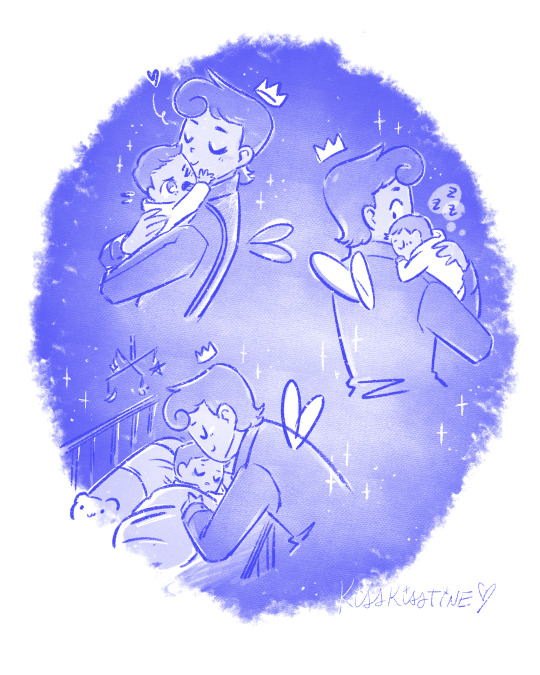
"Goodnight, my kiddo."
Peri taking (BABY) Dev to bed. Request from @mortallysteadydeer.
These were some loose sketches from my previous comic but fleshed out the sketches with a baby Dev and Peri instead!
While I was drawing this I thought of a story about Peri begging Jorgen to be Dev's fairy godparent again but Jorgen utterly refusing. After several more pleas, Jorgen caves in and grants Peri's one more fairy godparent opportunity with Dev. This time it's to go back in time to ease a lonely 8-month old Dev through the apex of his parents' divorce-- but only for 1500 mins. Jorgen works with Father Time who transports Peri 9(ish) years into the past attaching an hour glass watch to Peri's wrist that will take him back to the present after 1500 mins. Peri, disguised as Dev's hired full-time nanny, happily reunites with him, transforming Dev's lonely room into a magical enclave and protecting him from the arguments between his parents, as Dev's father, Dale wins to take full custody. Just as Peri spends his last hour napping with Dev, Dev's fraught mother secretly takes Dev and runs away with him. Peri wakes up to Dale screaming in the other room as Dev goes missing on his smart watch tracker. Dale and Peri panic, and after a short blame game, Dale rushes off to search with a fleet of O-PAIR drones and Peri frantically tries to figure out his own plan knowing he only has 1 hour left in the past, and just as all seems lost, Nick-of-Time poofs in to help extend Peri's time in need!
(;v; ) That's all I'm gunna write out so far! I have an ending in mind but I'll keep it to myself for now as it reveals Dev's mother, who was one of the existing characters from the original series. Huhuhuhu!
#fairly oddparents#fop a new wish#fairly odd parents a new wish#dev dimmadome#peri#periwinkle#a new wish#dev#fop dev#fop peri#peri fairly oddparents#dev fairly oddparents#baby dev#baby development#fanart#facfic idea#dale dimmadome wasn't THAT bad of a dad in the beginning.. or so it seems
542 notes
·
View notes
Text


(That's not her Mama, it's her babysitter.)
Video description and transcript under the cut.
A conversation between a nine-month-old baby in a pink onesie and a skinny short-haired Black girl lying on her front on bed. The babysitter speaks earnestly to the baby in a thick Scouse accent. Baby babbles back in a perfect call-and-response, somehow with a hilarious syrupy Scouse intonation even without intelligible words.
Baby, wide awake and chatty: "Gah"
Babysitter: "Don't you want to go to sleep?"
Baby: "Nuh"
Babysitter: "Okay. Why don't you ever want to go to sleep?"
Baby: "Awu ke deeaey"
Babysitter: "You got energy?"
Baby: *turns and gestures behind them* "Lookasubababu"
Babysitter: *points over her shoulder* "I got your bottle, I got your teddy and then you started to—(unintelligible)"
Baby: "Ibuddku"
Babysitter: "I changed your bum"
Baby: "A dju ku jdooob!"
Babysitter: "I thought that's what you wanted to do."
Baby: "Awu ku shoo shi kwawu."
Babysitter: *matching the sing-song cadence* "Yeah but we've had a nice day together, and then you're taking a nap now."
Baby: "Awula ku sholey!"
Babysitter: "But why?"
Baby: "Awlu ku waai?"
Babysitter: "Yeah?"
Baby: "Aiw tuh paayi!"
Babysitter: *shaking her head playfully* "Yeah but you need to go to sleep 'cuz you're a baby."
Baby: "A'll ku shwaab ka daarkh!"
Babysitter: "Yeah, but you're a baby so you're meant to listen to what I'm sayin'."
Baby: "I'll ku showley!"
Babysitter: "Yeah but you're meant to be going to sleep because you're the baby."
Baby: "Au ku shooshe daaagh!"
Babysitter: *cracks up and faceplants on the bed*
Baby: *looking in confusion* "Awz we—" *then smiles widely at grown-up's laughter*
#baby talk#baby development#british accent#linguistics#language#child development#funny tiktok#kids say the darndest things#funny children#funny#laugh rule#wholesome#free serotonin#knee of huss
294 notes
·
View notes
Text
Characteristics of Infant Ages
2 Months -- recognizes familiar faces -- tracks objects with eyes
3 Months -- brings objects to mouth -- smiles -- frowns
4 Months -- reaches out to people -- drools
5 Months -- sleeps through the night -- recognizes family members from strangers
6 Months -- teething begins -- sits upright -- speaks one-syllable words
7 Months -- afraid of strangers -- mood swings
8 Months -- responds to "no" -- can sit alone -- plays peek-a-boo
9 Months -- pulls up to stand -- places objects in mouth to explore them
10 Months -- responds to name -- crawls efficiently
11 Months -- starts to walk without help -- frustrated with restrictions
12 Months -- knows name -- walks
.
Patreon
#studyblr#notes#medblr#medical notes#med notes#infant development#baby development#lifespan development#psychology#psychology notes#psych#psych notes#neurology#development#infant care#anatomy and physiology
16 notes
·
View notes
Text
Writing Babies
I love you all but some of you do not know how to write children, specifically babies. So today I'm going to break down everything I have learned from helping raise three kids (my little siblings). Not to mention the last two are still one and almost two respectively, as well as a cousin who is almost three. I will be using them as examples.
Zero-Six months: In the first six months a baby isn't going to be doing shit besides getting off its binky in the sixth. Though it is good to note that sometimes parents won't completely take their kids off of binkies, most tend to just transition them to only using their binky at night to sleep. The main reason I've found for this is so they aren't drinking so much formula at night. However, I will say some babies will start babbling around the end of this period, as well as starting to roll over at 4-6 months, which is crucial to crawling.
Six-Twelve months: This is when we start doing things!!! Specifically walking and crawling. Most babies will start crawling at 7-12 months, and most start walking from 10 to 12 months. However, it isn't uncommon for a baby to start early or late. I started walking at nine months, but my little sister didn't start walking until she was a year and six months, and my brother is a year and two months and he hasn't started walking yet. Now, towards the 11-12 month mark, babies might start saying full words. Using my brother as an example, he turned one two months ago (in May) and now has a few words he says. He says go, more, please, bye, mama, dada, and baba. My little sister, however, is turning two in August and has a larger vocabulary. She says names and tells when she's hungry or cold, or when she needs a diaper change. Younger babies don't have a big vocabulary, and most won't start saying full sentences until they're two years old. I will say this again, it is not uncommon for children to start earlier or later, so if you really want the one-year-old in your story to be talking and walking, specify the months.
On the topic of months, you know how a lot of people get annoyed when parents say 18, 20, or 14 months? Well, that's because until they're 2 1/2 - 3 there is a difference!!! They're still developing. Once you get to about 4 or 5 you can just say, 4 or 5, but a two-year-old is a lot less developed than a two and two and a half-year-old. Every month is a month a baby learns something. Hence why I'd say my sister is twenty-two months to a parent, but say she's two and a half to someone who doesn't know.
Remember to do your own research, but I hope this helped!!
#writing#writing tips#writing advice#writer stuff#baby development#thats such an odd tag#I forget there's people older than 20 on the internet sometimes#or like#people who have children
28 notes
·
View notes
Text
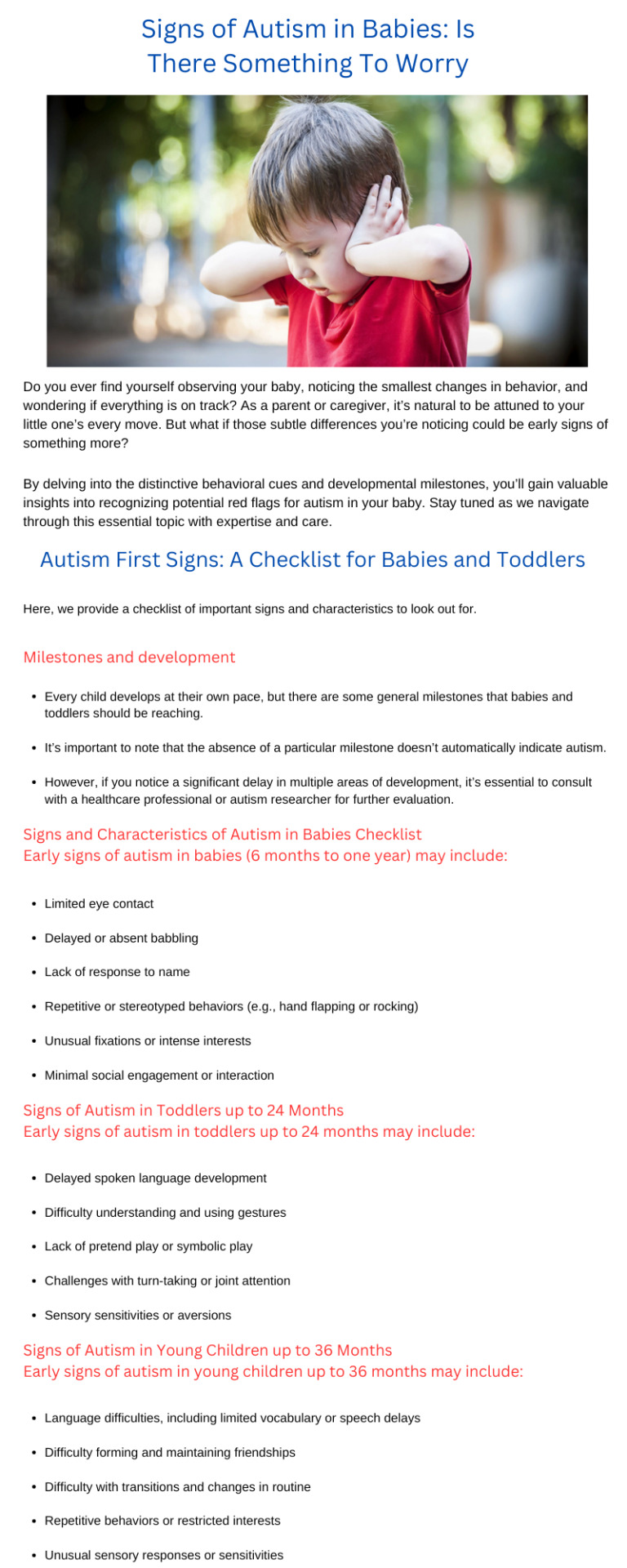
2 notes
·
View notes
Text
2 notes
·
View notes
Text
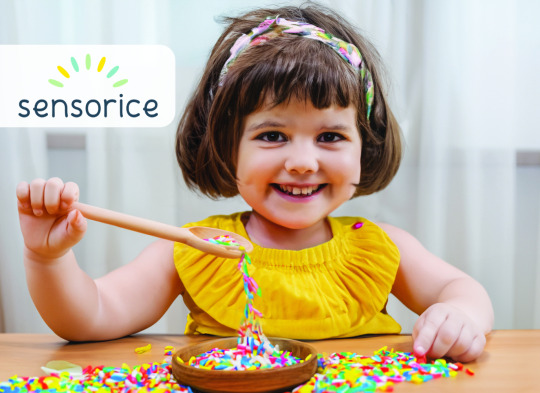
sensorice by Sensolern: Stimulating senses, inspiring play – where imagination meets sensory pleasure! 🤗
https://www.sensolern.com/
2 notes
·
View notes
Text
Exploring the Maternal and Baby Products Industry: Momcozy and the Ultimate Baby Carrier Tests Guide
Are you looking for the best baby carriers on the market? The maternal and baby products industry is thriving, and brands like Momcozy are leading the way in providing quality, comfort, and style for both parents and their little ones.
Momcozy specializes in innovative baby carriers that allow parents to keep their babies close while enjoying hands-free convenience. Their products are designed with both safety and comfort in mind, making them a top choice for new parents.
In our comprehensive baby carrier tests guide, we explore the various features of Momcozy carriers, including adjustable straps, ergonomic designs, and breathable fabrics. These carriers not only support your baby's development but also ensure that parents can enjoy a comfortable experience while on the go.
Choosing the right baby carrier can make all the difference in your parenting journey. With Momcozy, you can trust that you are investing in a product that prioritizes quality and user satisfaction. Join the many happy families who have discovered the joys of using Momcozy baby carriers!
0 notes
Text
Play Ideas to Strengthen Your Baby’s Leg Muscles: Guide for Parents in 2025
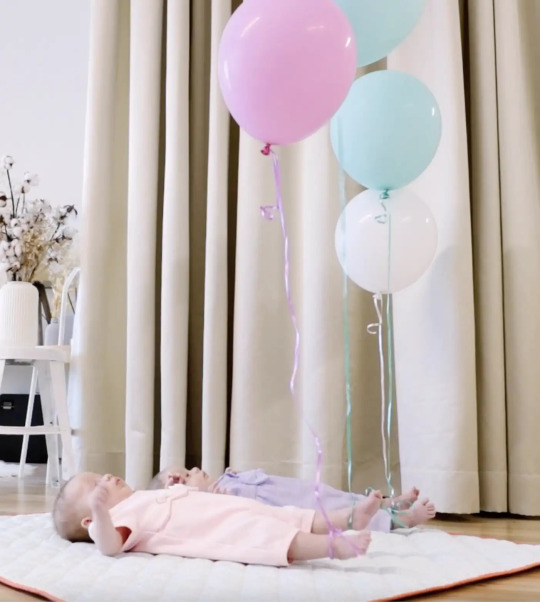
As your baby begins their journey through the early stages of life, one of the most exciting developments you’ll witness is their growing ability to move. From lifting their head to sitting upright, crawling, standing, and eventually walking, your child’s motor skills are built on a strong foundation—muscle development, especially in the legs.
Leg strength plays a critical role in gross motor milestones. Without adequate muscle support, babies may face delays in crawling, pulling to stand, and walking. The good news is, with thoughtful play and age-appropriate activities, you can encourage natural development while bonding with your baby in meaningful ways.
In this article, we’ll walk through expert-approved play ideas to help strengthen your baby’s leg muscles, backed by research and parenting insights. You’ll also find a set of frequently asked questions and a conclusion to guide your journey.
For more guidance and products that support developmental milestones, check out the original article on MonkiBox’s Community Blog.
Why Focus on Leg Muscle Development?
The leg muscles are central to a child’s gross motor skills. These muscles not only support mobility but also enhance coordination, balance, and posture. Developing strength in the quadriceps, hamstrings, calves, and hip flexors helps your child eventually transition from sitting to standing and walking.
The first year of a baby’s life is especially crucial. Encouraging safe and effective play ideas during this window ensures your baby’s physical milestones are met timely.
Key Principles Before Starting
Before we dive into the activities, keep these foundational principles in mind:
Tummy time is essential: A strong core supports leg muscle development.
Safety first: Always supervise and ensure a hazard-free space.
Every baby is unique: Respect your baby's pace—don’t rush milestones.
Make it playful: Babies thrive when learning is fun and interactive.
Age matters: Choose activities based on developmental stage, not just age in months.
1. Tummy Time with Leg Kicks
Age Range: Newborn to 6 Months
Tummy time is one of the first activities you’ll use to stimulate your baby's muscle strength.
How it helps: While it primarily works the neck and core, the natural kicking reflex also engages the glutes, thighs, and calves.
How to do it:
Lay your baby on a soft mat on their stomach.
Use a high-contrast or musical toy to capture their attention.
As they move to reach the toy or express excitement, you’ll notice leg kicks.
Pro Tip: Try lying in front of your baby to mimic their movement and encourage interaction.
2. Bicycle Legs
Age Range: 0–3 Months
This is a gentle movement that mimics the pedaling of a bicycle, helping develop joint mobility and leg muscle strength.
How to do it:
Lay your baby on their back.
Gently hold their legs and move them in a cycling motion.
Sing or talk during the process to maintain engagement.
Benefits:
Prevents stiffness
Supports digestion
Builds early leg coordination
3. Supported Standing on Your Lap
Age Range: 2–6 Months
Even before babies can stand independently, they enjoy the sensation of bearing weight on their legs.
How to do it:
Sit with your baby facing you on your lap.
Gently support them under the arms and allow their feet to touch your thighs.
Encourage gentle bouncing motions.
This helps to:
Strengthen thigh and calf muscles
Build neural connection between movement and stability
Caution: Avoid prolonged standing if your baby seems tired or uncomfortable.
4. Kick and Play Piano Gym
Age Range: 2–6 Months
Investing in a baby piano gym can turn leg movement into rewarding play.
How it works:
When babies kick the piano pedals, musical sounds are triggered.
This teaches cause and effect while encouraging repetitive kicking.
What to look for:
Soft pedals
Adjustable arch with hanging toys
Sensory-friendly design
Great for: Encouraging muscle memory and strengthening hamstrings and glutes.
5. Leg Pressing Against Resistance
Age Range: 3–6 Months
How to do it:
Place your hand or a soft object (like a rolled towel) against the sole of your baby’s feet.
Gently allow them to push.
Why it matters:
Engages leg muscles without overexertion
Builds strength and introduces resistance training safely
6. Rolling Over Practice
Age Range: 4–7 Months
Although rolling primarily involves the core, the motion of pushing off one leg and rotating uses the hip flexors and quadriceps.
Encourage rolling by:
Placing a favorite toy to one side
Helping them shift weight by gently guiding the hips
Note: Don’t overdo it—focus on one or two rolls at a time and make it enjoyable.
7. Obstacle Crawling
Age Range: 6–10 Months
Once crawling begins, you can enhance leg strength by offering resistance through soft obstacles.
Setup tips:
Use small pillows, rolled blankets, or play tunnels.
Place toys just beyond the obstacle.
Benefits:
Strengthens thighs, glutes, and calves
Enhances problem-solving and coordination
8. Cruising Along Furniture
Age Range: 9–12 Months
Babies pulling themselves up and moving along the edge of furniture (called cruising) is a major milestone.
Create a cruising-friendly space:
Ensure the furniture is sturdy and at chest level.
Place toys slightly out of reach to motivate side-stepping.
Muscles engaged:
Calves
Hip stabilizers
Inner thighs
Encouragement tip: Clap and celebrate their steps—positive reinforcement boosts confidence.
9. Push Toys and Wagons
Age Range: 9–15 Months
Push toys provide a safe way for babies to practice walking while stabilizing their steps.
Choose wisely:
Weighted bases
Anti-slip wheels
Ergonomic handles
Strengthens:
Calves
Ankles
Glutes
Overall coordination
10. Water Play or Infant Swimming
Age Range: 6 Months+
Why it works: Water provides resistance without strain, making it excellent for building strength.
Activities to try:
Kicking while supported
Floating on back with slight leg movement
Parent-assisted “swimming” motions
Caution: Always maintain direct contact and never leave your baby unattended near water.
11. Dance and Bounce Time
Age Range: All Ages
Dancing with your baby is not just fun—it’s beneficial. Holding your baby while bouncing gently to music stimulates vestibular development and engages leg muscles through rhythmic movement.
Bonus tip: Use a baby carrier with good leg support and bounce gently to the beat.
Tools and Toys That Support Leg Development
Activity gyms with piano pedals
Baby bouncers (limited use)
Soft play mats
Push walkers
Low-height furniture for cruising
Explore more parenting-approved tools on MonkiBox’s website, where curated play kits are designed to align with developmental stages.
Conclusion
Building your baby's leg muscle strength doesn't require fancy equipment or rigid routines. It’s all about intentional, interactive play. Each game, kick, or push brings your baby closer to essential milestones like crawling, standing, and walking.
As a parent, your presence and encouragement are just as important as the activities themselves. Whether it’s during tummy time, a rolling game, or pushing a toy wagon, these shared moments not only strengthen muscles but also deepen your bond with your little one.
Remember: progress looks different for every baby. Some may crawl early, while others take time to walk independently. Trust your instincts, consult your pediatrician if unsure, and most of all—enjoy the ride!
For a more detailed breakdown of baby development and activity ideas, explore this full article on MonkiBox.
Frequently Asked Questions (FAQs)
1. When should I start leg-strengthening activities with my baby?
You can begin gentle activities like tummy time and bicycle legs from birth. As your baby grows and gains head control, you can gradually introduce more dynamic movements like standing support or crawling games.
2. How do I know if my baby’s legs are getting stronger?
Look for milestones such as:
Kicking more forcefully during play
Bearing weight when held upright
Attempting to roll, crawl, or stand
Showing curiosity in movement
3. Are baby walkers safe for leg development?
Traditional baby walkers are generally not recommended by pediatricians, as they can interfere with natural walking development and pose safety risks. Instead, use push toys that promote upright movement with proper support.
4. What if my baby doesn’t enjoy these activities?
Every baby has different preferences. If one activity isn’t working, try another. Keep the sessions short, playful, and interactive. If your baby is consistently resistant to movement or seems delayed, consult a pediatrician.
5. How often should I do these exercises?
Aim for short daily sessions—a few minutes of tummy time multiple times a day, supported standing for 2–5 minutes, etc. Consistency is more important than duration.
6. Can these activities help my baby walk earlier?
These play ideas support natural progression, but rushing walking isn't advised. Babies walk when they are neurologically and physically ready—usually between 9 to 18 months.
7. Is resistance training safe for infants?
Yes, as long as it’s done gently and with bodyweight or minimal resistance like soft pushing against your hand. Avoid using weights or overexertion.
0 notes
Text
6 Blocks, Infinite Discovery
Touch. Lift. Return. Repeat.
This Montessori block tray is more than a wooden toy — it’s a quiet invitation to explore.
Each smooth, chunky block helps babies build strength, dexterity, and the confidence that comes from doing things all by themselves.
#montessori #woodentoys #babylearning #openendedplay #montessoriathome #sensoryplay #finemotor

https://www.buyme50gifts.com/montessori-toys-uk/
0 notes
Text
1 note
·
View note
Text
Exploring the Joys of Parenting with Momcozy Baby Carriers
Hello everyone! Today, I want to share some wonderful insights about the maternal and baby products industry, particularly focusing on the amazing brand Momcozy and their fantastic baby carriers. As a parent, finding the right baby carrier can truly enhance the bonding experience with your little one while making daily activities much easier.
Momcozy offers a range of baby carriers that prioritize comfort and safety for both the baby and the parent. Their designs are not only stylish but also practical, allowing parents to carry their babies hands-free while maintaining close contact. This is especially beneficial for busy parents who want to multitask without compromising on the comfort of their baby.
One of the standout features of Momcozy baby carriers is their ergonomic design, which ensures that your baby is supported properly. This reduces the risk of strain for the parent and promotes healthy hip development for the baby. Many parents rave about how easy it is to put on and take off the carrier, making it a perfect choice for outings.
Moreover, Momcozy understands the importance of versatility. Their baby carriers can be adjusted for different carrying positions, whether you prefer to have your baby facing in or out. This adaptability allows you to choose the best position for your baby’s comfort and your convenience.
In conclusion, Momcozy baby carriers are an excellent investment for any parent looking to enhance their parenting journey. With their focus on comfort, safety, and style, they provide an enjoyable experience for both parents and babies. If you’re in the market for a baby carrier, I highly recommend checking out Momcozy! Happy parenting!
0 notes
Text
The Perfect First Toy: Benefits of the Bouncing Yellow Duck for Babies
As new parents, choosing the right toys for your baby is both exciting and daunting. You want to ensure that the toys you select are not only safe but also help stimulate your baby’s development during those critical early months. One toy that perfectly combines fun, learning, and sensory engagement is the Bouncing Yellow Duck.
This charming, colorful toy is not only adorable but also provides multiple developmental benefits for babies. From improving motor skills to encouraging sensory exploration, the Bouncing Yellow Duck can play an essential role in your baby’s growth and development while keeping them entertained. In this article, we will explore the numerous benefits of the Bouncing Yellow Duck, and why it’s the perfect first toy for your little one.
What is the Bouncing Yellow Duck?
The Bouncing Yellow Duck is an interactive, playful toy designed for babies. Typically made of soft, durable, and baby-safe materials, this toy features a bright yellow duck that bounces or wiggles when activated by a gentle tap or touch. Some versions may feature lights, music, or other sounds that engage your baby’s auditory senses.
Its fun and bouncy movements catch the attention of babies, prompting them to reach out and engage with the toy, making it an excellent first toy for promoting physical activity and sensory exploration.
Why is the Bouncing Yellow Duck the Perfect First Toy?
1. Encourages Motor Skill Development
One of the primary benefits of the Bouncing Yellow Duck is its ability to encourage babies to develop their motor skills. As babies interact with the duck, whether by tapping, reaching, or attempting to make it bounce, they practice the fundamental movements that form the foundation for future motor abilities.
Gross Motor Skills: The duck’s movement can inspire babies to engage in gross motor activities such as reaching, pushing, or moving their bodies in response to the toy. For example, if the duck bounces in a particular direction, the baby may try to crawl toward it or reach for it, strengthening their core muscles and improving coordination.
Fine Motor Skills: Holding onto the duck, tapping it, or trying to make it bounce encourages the use of small muscles in the hands and fingers. These actions help babies develop their hand-eye coordination and refine their fine motor skills, which are essential for future tasks such as holding a spoon, grasping objects, or even drawing.
By encouraging both gross and fine motor development, the Bouncing Yellow Duck provides well-rounded stimulation for your baby’s physical growth.
2. Promotes Sensory Exploration
Babies are constantly exploring their senses, and toys that engage multiple senses help them make sense of the world around them. The Bouncing Yellow Duck provides sensory stimulation in various forms:
Visual Stimulation: The bright yellow color of the duck, combined with its playful movement, captures your baby’s attention and aids in the development of visual tracking. As babies watch the toy bounce or wiggle, they practice focusing on moving objects, which improves their visual processing and coordination.
Auditory Stimulation: Many versions of the Bouncing Yellow Duck include sound effects, such as squeaks, gentle music, or even the sound of a quacking duck. These sounds not only captivate your baby’s attention but also help with auditory development, encouraging babies to listen, recognize different sounds, and learn about cause-and-effect relationships (i.e., when the duck bounces, it makes a noise). Auditory stimulation plays an essential role in language development, so it’s a great way to support your baby's communication skills.
Tactile Stimulation: The material of the Bouncing Yellow Duck is usually soft and baby-friendly, allowing babies to explore different textures through touch. As babies touch, grasp, and hold the toy, they develop their sense of tactile awareness and begin to understand the relationship between textures and their physical interactions with the world.
By engaging multiple senses, the Bouncing Yellow Duck helps babies understand and connect with their environment, which is crucial for their early cognitive development.
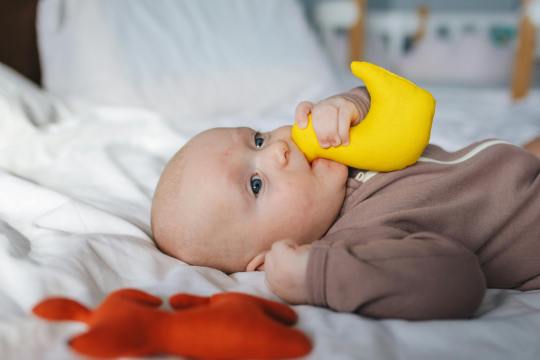
3. Encourages Visual Tracking and Focus
A significant developmental milestone for babies is the ability to follow and track moving objects with their eyes. The Bouncing Yellow Duck offers an excellent opportunity for babies to practice this skill. As the duck bounces, babies are encouraged to track its movements visually, which helps improve their eye coordination and focus.
Visual tracking is an essential skill that lays the foundation for many future abilities, including reading and writing. The more babies engage with visually stimulating toys like the Bouncing Yellow Duck, the better they become at focusing and processing visual information.
4. Supports Emotional Development
Though babies are still learning how to communicate their feelings, interacting with toys like the Bouncing Yellow Duck can help support emotional development. As babies watch the toy move and react to it, they experience a sense of excitement and curiosity. The joy of watching something move and respond can bring a sense of accomplishment when they engage with it successfully.
Additionally, as babies grow older, they begin to associate certain toys with comfort and happiness. The Bouncing Yellow Duck can become a source of comfort and emotional security, especially if they enjoy the toy’s playful movements and sounds. This emotional attachment to a toy can help babies feel more secure and self-assured.
5. Encourages Independent Play
While the Bouncing Yellow Duck can certainly be enjoyed with a caregiver, it also encourages independent play. Babies can interact with the toy on their own, tapping it, watching it bounce, and experimenting with how to make it move. This fosters a sense of autonomy and independence as babies realize they can make the toy respond to their actions.
Independent play is an important aspect of child development, as it helps babies build problem-solving skills, confidence, and creativity. Even though the Bouncing Yellow Duck is simple in design, it allows babies to begin experimenting with the cause-and-effect relationship: “If I touch it, it moves,” which is an early lesson in understanding how their actions affect the world around them.
6. Safe and Eco-Friendly Material
The Bouncing Yellow Duck is made from baby-safe, non-toxic materials that are soft to the touch and free from harmful chemicals. This makes it an ideal first toy, especially for babies who tend to put toys in their mouths as they explore the world around them. Many versions of this toy are crafted from eco-friendly materials, ensuring that your baby is not only safe but also surrounded by sustainable, environmentally conscious products.
With the increasing demand for eco-friendly products, choosing toys made from natural materials such as wood or BPA-free plastic is a smart choice. The Bouncing Yellow Duck provides peace of mind for parents who want to ensure that their child is playing with a safe, environmentally friendly toy.
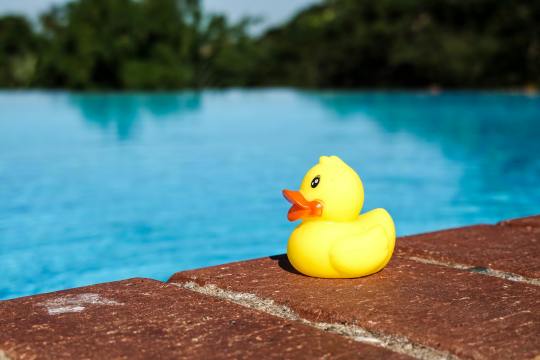
7. Perfect for Early Learning and Interaction
The Bouncing Yellow Duck serves as a great early learning tool that promotes positive parent-child interaction. Parents can join in the fun by tapping the toy and encouraging their baby to engage with it. This type of interaction fosters bonding and creates an opportunity for shared play.
As babies engage with the duck, parents can introduce words like “bounce,” “yellow,” or “duck,” supporting language development. Interactive toys like this also provide a foundation for future learning activities, as they encourage curiosity, exploration, and communication.
Where to Find the Bouncing Yellow Duck
If you’re looking for a fun and educational first toy for your baby, the Bouncing Yellow Duck is a perfect choice. To find this charming toy and other developmental toys for babies, visit Nav Emporium. They offer a curated selection of baby-friendly, eco-conscious toys designed to foster development in the early stages of life.
Conclusion
The Bouncing Yellow Duck is the ideal first toy for babies, offering a delightful combination of sensory stimulation, motor skill development, and emotional engagement. Its simple yet effective design encourages babies to explore movement, sound, and touch, helping them develop essential skills that will benefit them as they grow.
Whether you’re looking to encourage your baby’s fine motor skills, promote independent play, or just provide a source of fun and comfort, the Bouncing Yellow Duck delivers on all fronts. With its vibrant colors, interactive features, and eco-friendly materials, it’s the perfect addition to your baby’s toy collection.
To purchase the Bouncing Yellow Duck and explore other developmental toys for babies, visit Nav Emporium.
Tags: #BouncingYellowDuck #FirstToy #BabyDevelopment #SensoryToys #MotorSkills #EcoFriendlyToys #LearningThroughPlay #NavEmporium #ToysForBabies #InteractiveToys.
0 notes
Text
https://kiddipedia.com.au/why-you-should-embrace-sustainable-baby-gifts/
0 notes
Text
Exploring the Best Baby Carriers: A Guide for New Moms
As a new mom, finding the right baby carrier can be an exciting journey! With so many options available, it’s important to choose the one that fits your lifestyle and keeps your little one comfortable.
One brand that stands out in the maternal and baby products industry is momcozy. Known for its innovative designs and focus on safety, momcozy offers a variety of baby carriers that cater to different needs.
To help you make an informed decision, we've created a comprehensive guide on the best baby carriers, including various tests and reviews. Whether you're looking for a soft-structured carrier for everyday use or a wrap for a more snug fit, our guide covers it all.
Key points to consider when selecting a baby carrier include comfort, ease of use, and the ability to support your baby's development. Momcozy's carriers are designed with these factors in mind, ensuring both you and your baby enjoy your time together.
Remember, the right baby carrier can enhance your bonding experience and make outings more enjoyable. Happy carrying!
#maternal products#baby development#soft-structured carrier#baby carriers#outings#ease of use#comfort
0 notes
